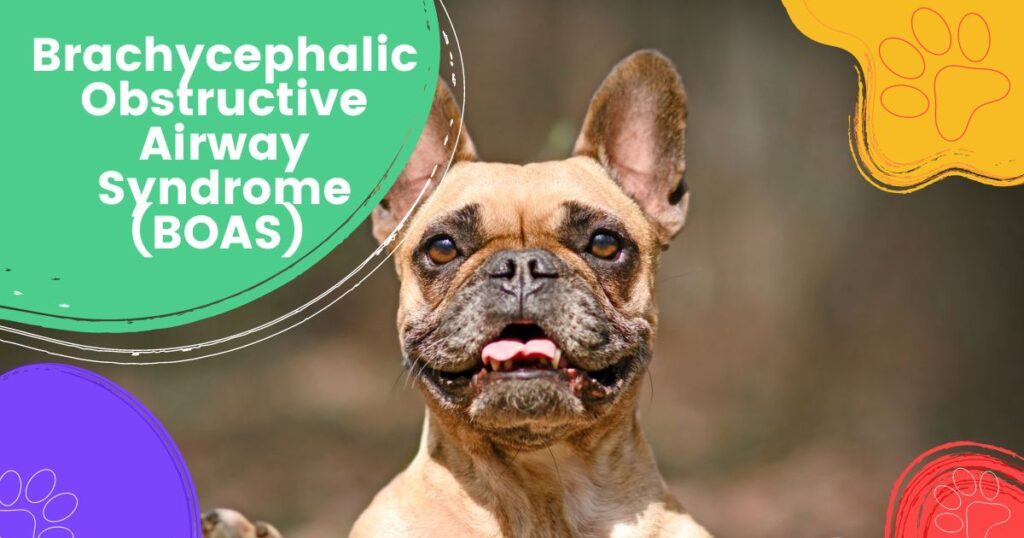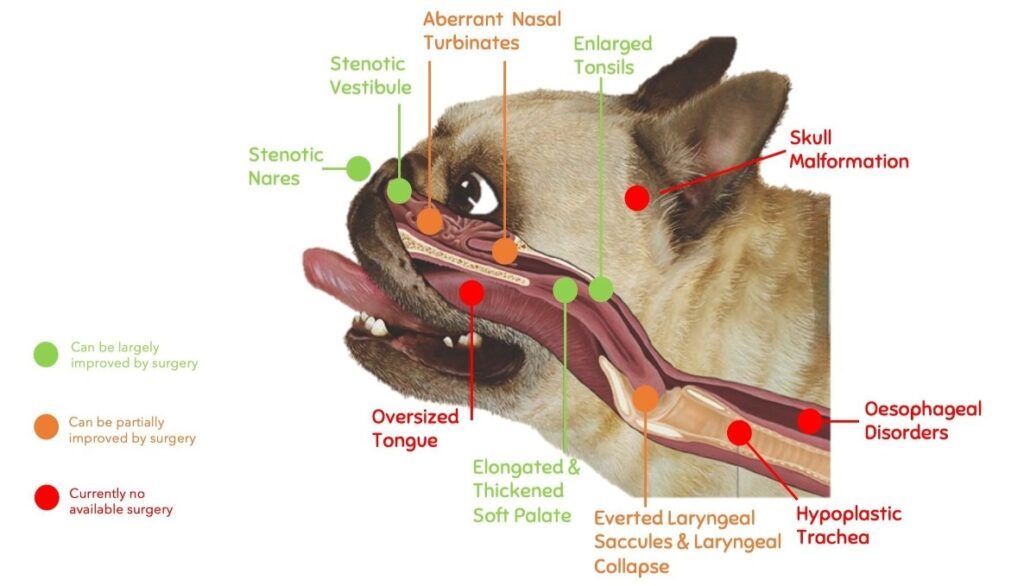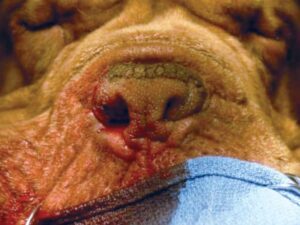Что означает брахицефаль?
Термин «брахицефальный» происходит от греческого брахи, означающего «короткий», и головы головы, то есть брахицефальные животные - это те, у кого короткие головы.
Следовательно, у брахицефальных собак или кошек есть кости черепа, которые укорочены по длине, придавая лицу и носу толкование. Из -за более коротких костей лица и носа анатомия и взаимосвязь с другими структурами мягких тканей изменяются; Некоторые из этих изменений могут вызвать физические проблемы для пораженного животного.

Что такое брахицефальный обструктивный синдром дыхательных путей (BOAS)?
Брехицефальный обструктивный синдром дыхательных путей - это термин, который дает эффекты, которые укороченная голова этих животных оказывает на прохождение воздуха через верхние дыхательные пути. Знаки могут варьироваться в зависимости от грубости от легкого храпа или фырканье, до сильных проблем с дыханием.
Животные, страдающие клинически значимым Боасом, могут изо всех сил пытаться дышать во время упражнений и могут пострадать от коллапса из -за отсутствия воздуха. Опора собак на дыхание, чтобы охладить себя, также заставляет животных, страдающих от Боаса, очень восприимчивыми к перегревам и развитию потенциально очень серьезных трудностей для дыхания в горячих условиях.

Какие породы затронуты?
Брехицефальные породы включают в себя пород собаки и кошки, которые имеют очевидный, характерный короткий или раздавленный вид носа. Любая порода собаки или кошки с брахицефальной конформацией головы может быть затронута, например:
Собаки:
Бостонский терьера, боксер, боксерская собака, бычья мастиф, бульдоги (французский и английский), король Кавалер Чарльз Спаниль, китайский шар-пей, Dogue de Bordeaux, Lhassa apso, Pekingese, Pug, Shih tsu
Кошки:
Персидский, Гималайский
Почему у этих животных проблемы?
Для этих животных есть четыре основных областях, касающихся этих животных:
В то время как собаки обычно представлены ветеринарам с клинически значимыми проблемами, возникающими в результате BOAS, кошки редко представляются для лечения. Это может отчасти отражать более сидячий образ жизни некоторых кошек по сравнению с собаками; Большинство кошек, которые представлены, требуют только лечения суженных NARES (ноздри).
Суженные NARES (ноздри) могут значительно повысить устойчивость к воздушному потоку в носу брахицефальных пород. Это, в сочетании с тенденцией, чтобы хрящевые опоры NARES обрушились во время вдохновения, требует гораздо больших усилий, чем обычно для дыхания.
Мягкий небо, перекрываемое мягким небом может частично препятствовать воздушному потоку в трахею (ветровой горки), а также вызвать турбулентный воздушный поток в области гортани (голосовая коробка). Оба эти эффекта еще больше увеличивают усилия, необходимые для того, чтобы затронутое животное дышило, и может вызвать значительное воспаление верхних дыхательных путей.
К сожалению, дополнительные усилия, необходимые для того, чтобы вдохнуть (вдохновение) в конечном итоге приводит к вторичным проблемам, поскольку дыхательные пути не адаптируются для того, чтобы справиться с турбулентностью и повышенным негативным давлением, которое развивается.
Эти вторичные эффекты включают:
Как диагностируется Боас?
При проведении физического обследования ваш ветеринар первичной медицинской помощи оценит вашу собаку или анатомию кошки (некоторые головы короче других) и поведение вашего питомца при определенных обстоятельствах.
Большинство брахицефальных животных будут испытывать степень обструкции верхних дыхательных путей, обычно очевидные как фырканье или храп. Ключ для вас и вашего ветеринарного хирурга, который выбирает между вами, испытывает ли ваш питомец значительный уровень признаков или демонстрирует анатомическую конформацию, которая может предрасполагать его/ее к проблемам. Обсуждение будет включать в себя то, как ваш питомец справляется с физическими упражнениями или теплыми условиями, а также с любой вероятностью восприимчивости к вторичному ухудшению в дыхательных путях.
К сожалению, только NARES (ноздри) могут быть должным образом оценены без требования об общем анестезии. Первоначально, следовательно, диагноз основан на общей оценке ветеринарного хирурга, но потребует дальнейшего изучения для подтверждения диагноза.
Как ветеринарный хирург исследует Боа?
Может потребоваться несколько тестов, в зависимости от выводов первоначального физического обследования. Они могут включать в себя анализы крови, оценки сердца (сердца) и рентген грудной клетки. Тем не менее, полная оценка дыхательных путей потребует анестезии.
Общая анестезия у брахицефальных собак может быть связана с повышенным риском, особенно на этапах индукции и восстановления.
Многие ветеринарные хирурги первичной медицинской помощи предпочитают направить эти случаи опытному хирургу для оценки дыхательных путей под общим анестезией, с тем, что хирургическое лечение может проводиться при одном и том же анестезии и, следовательно, снижает риски на этапе восстановления.
Хирург может использовать эндоскоп (небольшая камера) для изучения пищевода на наличие знаков желудочного рефлюкса.
Какие варианты лечения доступны?
Стенотические нари (суженные ноздри)
Удаление участка хряща передней части носа или секции кожи рядом с носом может улучшить поток воздуха через NARES.

Dogue de Bordeaux после операции с одной стороны, чтобы улучшить поток воздуха через ноздри.
Overlong Soft небо
Избыточная длина мягкого неба может быть уменьшена путем операции, чтобы уменьшить помехи с воздушным потоком в гортань (голосовая коробка).

Перед операцией сократить мягкое небо

После операции по сокращению мягкого неба
Гортань коллапс
Ранний коллапс гортани иногда можно улучшить путем удаления некоторых тканей, которая замедляет воздушный поток. Хирург оценит гортань (голосовую коробку) и решит, является ли дополнительная операция в этой области подходящей или может быть полезной. Иногда эту дополнительную процедуру, возможно, потребуется провести позднее.
Тяжелый (3 -й класс) коллапс вряд ли выиграет от незначительной процедуры и может потребовать постоянного трахеостомии (дыхание в шею) или иногда может быть временно улучшено с помощью процедуры связи (см. Информационный лист паралича гортани).
Эверные миндалины
Некоторые случаи могут выиграть от тонзиллэктомии (удаление миндалин). Решение о том, является ли это уместным, принимается во время оценки и хирургии.
Кислотный рефлюкс
Лечение желудочного рефлюкса обычно включает в себя регулярные лекарства, скорее, как можно принять из изжоги.
Хельскую грыжу
В целом, консервативное управление первоначально используется в случаях, страдающих перемещением секции желудка в грудь, хотя в некоторых случаях требуется хирургическое лечение.
Управление весом
Образ жизни многих из этих пациентов может предрасполагать их к ожирению. Потеря веса может значительно улучшить поток воздуха через глотку и шею и должна стать частью протокола лечения у пациентов с избыточным весом.
Какой прогноз (перспективы) для моей собаки или кошки?
Большинство собак, страдающих от клинических признаков BOA, которые получают быстрое подходящее лечение, могут испытывать значительное улучшение устойчивости физических упражнений и простоты дыхания. Однако, поскольку хирург никогда не сможет создать совершенно нормальные дыхательные пути для брахицефальных животных, они остаются восприимчивыми к тепловому стрессу, и многие из них вряд ли смогут осуществить до уровня, который можно ожидать от животных с нормальной конформацией головы.
Обычно надеется, что операция на NARES, мягкое небо и гортань замедлит прогрессирование коллапса гортани (коллапс голосовой коробки), улучшая воздушный поток и уменьшая негативное давление, возникающее во время дыхания. Ранняя операция, проведенная до коллапса гортани, стала тяжелой, должна максимизировать выгоду от хирургии и минимизировать риск значительного коллапса гортани в более позднем возрасте.
Многие собаки не испытывают значительного дальнейшего ухудшения гортани в течение жизни и, следовательно, никогда не требуют дальнейшей операции. К сожалению, несмотря на лечение, коллапс гортани может достичь критического уровня в некоторых случаях и может потребовать дальнейшей операции в какой -то момент в будущем.
Несмотря на многочисленные меры предосторожности, принятые ветеринарными хирургами при оценке и лечении этих пациентов, риск общей анестезии и хирургии в дыхательных путях никогда не может быть устранен. Хирурги и анестезиологи в направлениях специалистов в Северном Даунсе остро осознают особые потребности пациентов с брахицефальным языком, перенесших общую анестезию и хирургию дыхательных путей.
Гипопластическая трахея (небольшая наклона) не может рассматриваться, и эти собаки часто сильно подвержены сильному воздействию нарушения воздушного потока, связанного с этим состоянием.

| печенье | Продолжительность | Описание |
|---|---|---|
| cookielawinfo-checkbox-analytics | 11 месяцев | This cookie is set by GDPR Cookie Consent plugin. The cookie is used to store the user consent for the cookies in the category "Analytics". |
| cookielawinfo-флажок-функционал | 11 месяцев | The cookie is set by GDPR cookie consent to record the user consent for the cookies in the category "Functional". |
| cookielawinfo-checkbox-necessary | 11 месяцев | This cookie is set by GDPR Cookie Consent plugin. The cookies is used to store the user consent for the cookies in the category "Necessary". |
| cookielawinfo-checkbox-others | 11 месяцев | This cookie is set by GDPR Cookie Consent plugin. The cookie is used to store the user consent for the cookies in the category "Other. |
| cookielawinfo-флажок-производительность | 11 месяцев | This cookie is set by GDPR Cookie Consent plugin. The cookie is used to store the user consent for the cookies in the category "Performance". |
| просмотрено_cookie_policy | 11 месяцев | Файл cookie устанавливается плагином GDPR Cookie Consent и используется для определения того, дал ли пользователь согласие на использование файлов cookie. Он не хранит никаких личных данных. |